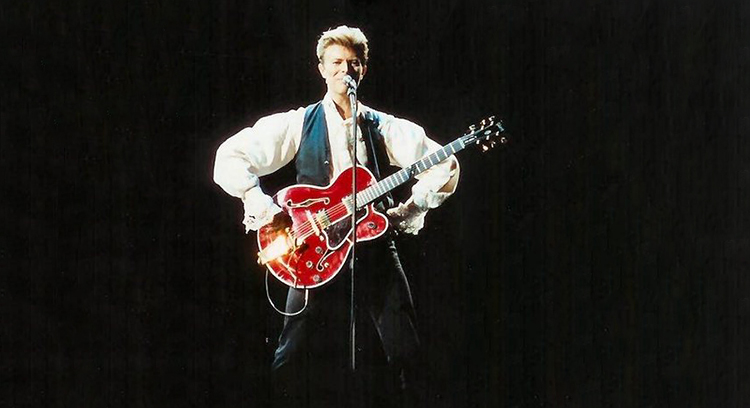David Bowie and the Art of the Performance

By R.P. Higgins
Electric Picture Display Systems
In 1990, David Bowie put on one of his most active productions — the “Sound and Vision” tour. At the time, I was a regional sales manager for GE Projection Display Products, and my biggest customer was Performance AV of Washington, DC. Performance AV did a tremendous amount touring with major acts in the day, providing IMAG for The Rolling Stones, Whitney Houston, Alan Jackson, Grateful Dead, Paul McCartney and many, many more. They bought a lot of GE PJs, MLVs and 3LV projectors for these tours, so you try to take care of customers like this.
For the Bowie Tour the production, including the projection, was to be creative — something different than simply having two screens flanked left/right of stage so promoters could move into larger venues, arenas and stadiums, and justify a higher price ticket since the fan would get to visualize his/her favorite singer from the Bob Uecker seats — way in the back. GE had just introduced the Multi-Scan Talaria MP series. This projector was two years in development. Getting that modulated oil layer to switch from low res/interlaced NTSC video to a non-interlaced 640×480 PC output created a rainbow-colored boat wake running diagonally through the image that would take about 15 minutes to dissipate (Every Talaria operator will tell you his/her own endearing story). In any event, Performance purchased a bunch of the new series MP units for the Bowie tour. Peter Daniel and Lee Griffin from Performance asked that someone from GE accompany the projectors to the Ft. Lee, NJ armory where Bowie was staging rehearsals. Having greatly admired DB’s music since 1974, this was a no brainer. Packed up the car and headed north on I-95.
After passing though the base main gate, I approached the Armory entrance and was stopped by an armed guard to ensure I was on a special list for entrance. I was thinking — quite the contrast of a peaceful artist from England being guarded by the U.S. Army National Guard. The “Sound and Vision” set was enormous. My task was to make sure the 160-pound Talaria MPs came out of the box and worked on each screen (in the actual show these would be double-stacked). This would be for production work — ironing out camera fades/switches and interspersing other media. The set-up was for two flanked screens rear projected. That meant stripping off projector covers, rolling up sleeves and starting the 15 minute procedure to re-flat field to center the electron beam, which had to be done for each (yeah, you can switch today’s projector orientation with your iPhone now). These projected images, however, were circular, with unused video masked. This was a cool effect that no one, to my recollection, had ever done before on tour.
What I found really telling about this artist — David Bowie — is how meticulous he was about the performance. This tour had a great deal of choreography — dancers throughout the show performing while the band and Bowie wailed away. The band was just killer with Adrien Belew’s guitar work being most memorable. The one incident I recalled best was Bowie taking a 30-second segment of one song and going over it again and again for 45 minutes until everything was right. He had to keep everyone in good spirits and I was within earshot of hearing him instructing, cajoling, encouraging and motivating the dancers and his band to get it just right. This was going to be a good show.
Peter, Lee and Greg Gerner invited my wife Pam and me to see Bowie at Merriwheather Post Pavillion later that year. What made the show even cooler (not done when I was at rehearsal that winter) was the show opening. There was a 70mm Xenon film projector with a really long throw lens shooting onto what must have been a 60’w x 35’h theater scrim in front. Projected onto the scrim was a 30′ tall “projected Ziggy” Bowie looking down at “live, Tin Machine” Bowie, illuminated from a solo overhead stage spot (rest of stage behind scrim completely blacked out). Opening lyric was “Ground Control to Major Tom” — Ziggy singing to Tin Machine alter ego — alternating lines of the verse. When the lyric “This is Ground Control to Major Tom” came up, the band kicked in — the scrim came up, the 70mm film projector masked/dowsed, then Bowie rushed to stage front with every light on the set illuminating the band, singers and dancers. An amazing opening what was to be one of the most entertaining evenings ever enjoyed.
My takeaway: David Bowie showed how hard you had to work to get the show just right. The image of rock stars sitting around partying all the time could not have been further from the truth with him. He will be forever remembered in his music and films. For me, “Little Drummer Boy” with Bing Crosby and “Under Pressure” with Freddy Mercury demonstrated his enormous range of creativity and ability to collaborate. As a screen actor, he played Tesla in one of my all time favorites — The Prestige. The guy had class and style, and for me was the hardest working guy I had ever seen in show business.
RIP – Lee Griffin and Greg Gerner. Thanks for everything. You both — and Peter — are the best.


